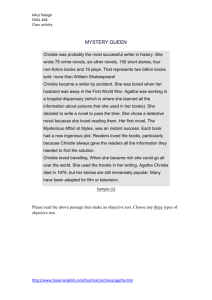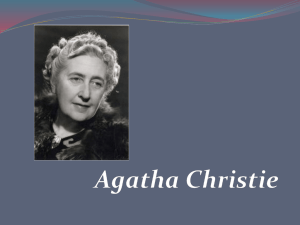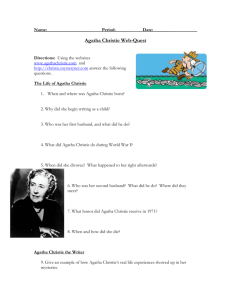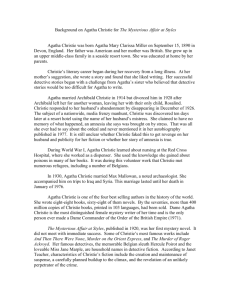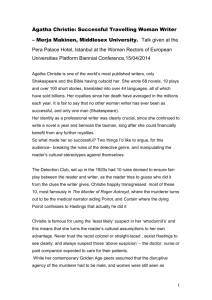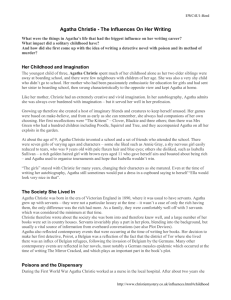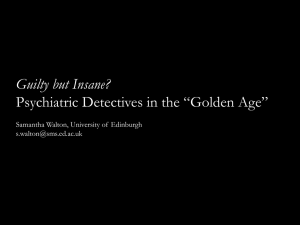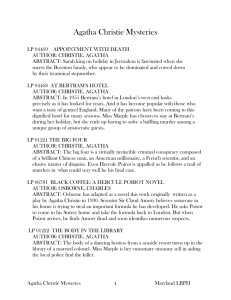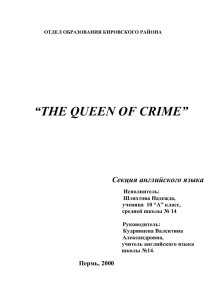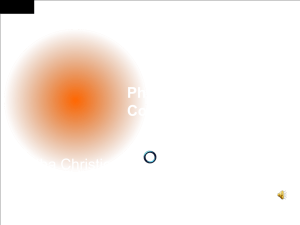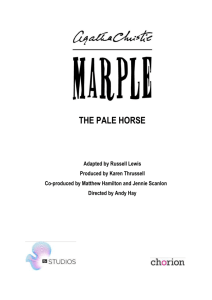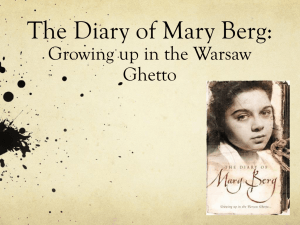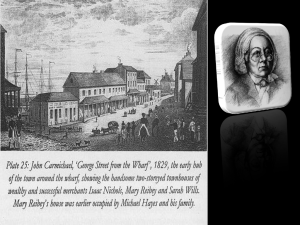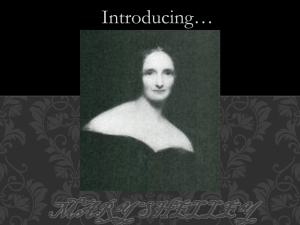Agatha Mary Clarissa
advertisement
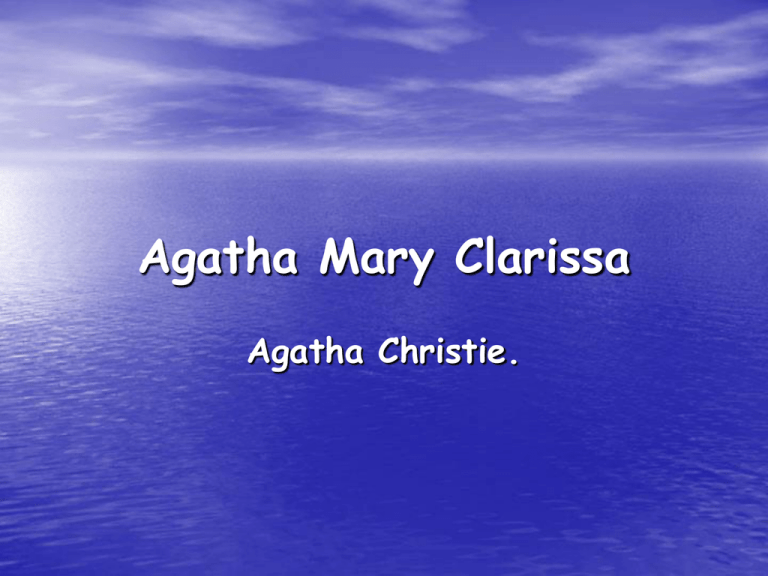
Agatha Mary Clarissa Agatha Christie. • Dame Agatha Mary Clarissa Christie, DBE (née Miller; 15 September 1890 – 12 January 1976) was a British crime writer of novels, short stories, and plays. She also wrote six romances under the name Mary Westmacott, but she is best remembered for the 66 detective novels and more than 15 short story collections she wrote under her own name, most of which revolve around the investigations of such characters as Hercule Poirot, Miss Jane Marple and Tommy and Tuppence. She also wrote the world's longest-running play The Mousetrap. Childhood: 1890–1910. • Agatha Mary Clarissa Christie was born on 15 September 1890 into a wealthy upper middle-class family in Ashfield, Torquay, Devon in South West England. Christie's mother, Clara Boehmer was an Englishwoman who had been born in Belfast, modern day Northern Ireland, in 1854 to Captain Frederick Boehmer and Mary Ann West; the couple's only daughter, she had four brothers, one of whom died young. Captain Boehmer was killed in a riding accident while stationed on Jersey in April 1863, leaving Mary Ann to raise her children alone on a meagre income. Under financial strain, she sent Clara to live with her aunt Margaret Miller née West, who had married a wealthy American Nathaniel Frary Miller in 1863 and lived in Prinsted, West Sussex. Clara stayed with Margaret and there she would meet her future husband, an American stockbroker named Frederick Alvah Miller the son of Nathaniel. Frederick was a member of the small and wealthy American upper class, and had been sent to Europe to gain an education in Switzerland. Considered personable and friendly by those who knew him, he soon developed a romantic relationship with Clara, and they were married in April 1878. Their first child, Margaret "Madge" Frary Miller (1879–1950) was born in Torquay, where the couple were renting lodgings, while their second, Louis "Monty" Montant (1880– 1929) was born in the U.S. state of New York, where Frederick was on a business trip. Clara soon purchased a villa in Torquay, named "Ashfield", in which to raise her family, and it was here that her third and final child, Agatha, was born. Early literary attempts and the First World War: • Returning to England in 1910, Agatha found that her mother Clara had been taken ill, and so they decided to head for a holiday in the warmer climate of Cairo in Egypt, then a part of the British Empire and a popular tourist destination for wealthy Britons. Returning to Britain, she continued her social activities in search of a husband, also taking part in writing and performing in amateur theatrics, helping to put together a play called The Blue Beard of Unhappiness with a number of female friends. Her writing extended to both poetry and music, and some of her early works saw publication, but she decided against focusing on either of these as future professions. It was while recovering in bed from an illness that she penned her first short story; entitled "The House of Beauty", it consisted of about 6000 words and dealt with the world of "madness and dreams" which fascinated Christie. Later Christie biographer Janet Morgan would comment that while it suffered from "infelicities of style", it was nevertheless "a compelling story". Disappearance. • In late 1926, Christie's husband Archie revealed that he was in love with Nancy Neele, and wanted a divorce. On 3 December 1926, the couple quarrelled, and Archie left their house Styles inSunningdale, Berkshire, to spend the weekend with his mistress at Godalming, Surrey. That same evening, around 9.45pm, Christie disappeared from her home, leaving behind a letter for her secretary saying that she was going to Yorkshire. On 14 December 1926, Agatha Christie was identified as a guest at the Swan Hydropathic Hotel (now the Old Swan Hotel) in Harrogate, Yorkshire, where she had been registered as 'Mrs Teresa Neele' from Cape Town, since the day of her disappearance. Christie never explained her disappearance from Surrey. Although two doctors had diagnosed her as suffering from psychogenic fugue, opinion remains divided. A nervous breakdown from a natural propensity for depression may have been exacerbated by her mother's death earlier that year and her husband's infidelity. Public reaction at the time was largely negative, supposing a publicity stunt or attempt to frame her husband for murder. Critical reception. • The world's best-selling mystery writer, and often referred to as the "Queen of Crime", Agatha Christie is considered a master of suspense, plotting, and characterisation. Some critics however regarded Christie's plotting abilities as considerably exceeding her literary ones. The novelist Raymond Chandler criticised her in his essay, "The Simple Art of Murder", and the American literary critic Edmund Wilson was dismissive of Christie and the detective fiction genre generally in his New Yorker essay, "Who Cares Who Killed Roger Ackroyd?". Popular novels with heavy archaeological influences. • Murder in Mesopotamia (1936) – Christie's Murder in Mesopotamia is the most archaeologically influenced of all her novels as it is set in the Middle East at an archaeological dig site and associated expedition house. The Main characters included an archaeologist, Dr. Eric Leidner, as well as his wife, multiple specialists, assistants and the men working on the site. The novel is most noted for its careful description of the dig site and house, which showed the author had spent much of her own time in very similar situations herself. The characters in this book in particular are also based on archaeologists Christie knew from her personal experiences on excavations sites. • Appointment with Death (1938) – Appointment with Death is set in Jerusalem and its surrounding area. The death itself occurs at an old cave site and offers some very descriptive details of sites which Christie herself would have visited in order to write the book. • Death on the Nile (1937) – Death on the Nile takes place on a tour boat on the Nile. Many archaeological sites are visited along the way and one of the main characters is an archaeologist, Signor Richetti. • They Came to Baghdad (1951) – They Came to Baghdad was inspired by Christie's own trips to Baghdad with Mallowan, and involves an archaeologist as the heroine's love interest. •. • Agatha Christie died on 12 January 1976 at age 85 from natural • causes at her Winterbrook House in the north of Cholsey parish, adjoining Wallingford in Oxfordshire (formerly part of Berkshire). She is buried in the nearby churchyard of St Mary's, Cholsey. Christie's only child, Rosalind Margaret Hicks, died, also aged 85, on 28 October 2004 from natural causes in Torbay, Devon.[61] Christie's grandson, Mathew Prichard, was heir to the copyright to some of his grandmother's literary work (including The Mousetrap) and is still associated with Agatha Christie Limited.
